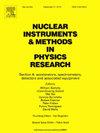Prototype of carbonless MRPC for MARQ experiment
IF 1.5
3区 物理与天体物理
Q3 INSTRUMENTS & INSTRUMENTATION
Nuclear Instruments & Methods in Physics Research Section A-accelerators Spectrometers Detectors and Associated Equipment
Pub Date : 2025-06-24
DOI:10.1016/j.nima.2025.170768
引用次数: 0
Abstract
The MARQ (Multi-Purpose Analyzer for Resonance and Quark Dynamics Spectrometer) experiment, an upcoming project at J-PARC in Japan, focuses on the development of two types of Multigap Resistive Plate Chambers (MRPCs) for tracking and time-of-flight (TOF) measurements. A critical issue during MARQ MRPC development was the shortage of carbon tape used as high-voltage electrodes. To address this difficulty, a small prototype with carbonless high-voltage electrode is built. A carbonless MRPC was designed with a 1-stack, 5-gap configuration, featuring 0.26 mm gaps and a 20 cm 20 cm active area. The carbonless high-voltage electrodes are composed of an array of copper pads connected via 100 k resistors, serve as quenching resistors. Both high-voltage electrodes and readout strips are integrated into a single multi-layer Printed Circuit Board (PCB). The prototype also incorporates factory-made mylar spacers to reduce the aging effects of fishing-line spacer and solid-silicon gaskets to ensure robust gas sealing. Performance was evaluated using an electron beam with a rate of approximately 10 Hz/cm, achieving around 95% efficiency and a time resolution of approximately 95 ps. However, stability remains a concern, as the efficiency decreases after two days of continuous beam operation. The suspected cause is current leakage within the multi-layer PCB. In the future, a thicker PCB will be tested to prevent the potential current leakage between high-voltage electrode and readout layer.
用于MARQ实验的无碳MRPC样机
MARQ(共振和夸克动力学光谱仪多用途分析仪)实验是日本J-PARC即将开展的一个项目,重点是开发两种类型的多间隙电阻板室(mrpc),用于跟踪和飞行时间(TOF)测量。在MARQ MRPC开发期间的一个关键问题是用作高压电极的碳带短缺。为了解决这个难题,我们制作了一个小型的无碳高压电极原型。设计了一种无碳MRPC,其结构为1层,5间隙,间隙为0.26 mm,有效面积为20 cm × 20 cm。无碳高压电极由铜衬垫阵列组成,通过100个kΩ电阻连接,作为淬火电阻。高压电极和读出条都集成到一个多层印刷电路板(PCB)中。该原型还采用了工厂制造的聚酯薄膜垫片,以减少钓鱼线垫片的老化影响,并采用固体硅垫片,以确保坚固的气体密封。使用速率约为10 Hz/cm2的电子束对性能进行了评估,效率约为95%,时间分辨率约为95 ps。然而,稳定性仍然是一个问题,因为连续两天后效率会下降。怀疑原因是多层PCB内漏电流。在未来,将测试更厚的PCB,以防止高压电极和读出层之间的潜在电流泄漏。
本文章由计算机程序翻译,如有差异,请以英文原文为准。
求助全文
约1分钟内获得全文
求助全文
来源期刊
CiteScore
3.20
自引率
21.40%
发文量
787
审稿时长
1 months
期刊介绍:
Section A of Nuclear Instruments and Methods in Physics Research publishes papers on design, manufacturing and performance of scientific instruments with an emphasis on large scale facilities. This includes the development of particle accelerators, ion sources, beam transport systems and target arrangements as well as the use of secondary phenomena such as synchrotron radiation and free electron lasers. It also includes all types of instrumentation for the detection and spectrometry of radiations from high energy processes and nuclear decays, as well as instrumentation for experiments at nuclear reactors. Specialized electronics for nuclear and other types of spectrometry as well as computerization of measurements and control systems in this area also find their place in the A section.
Theoretical as well as experimental papers are accepted.

 求助内容:
求助内容: 应助结果提醒方式:
应助结果提醒方式:


